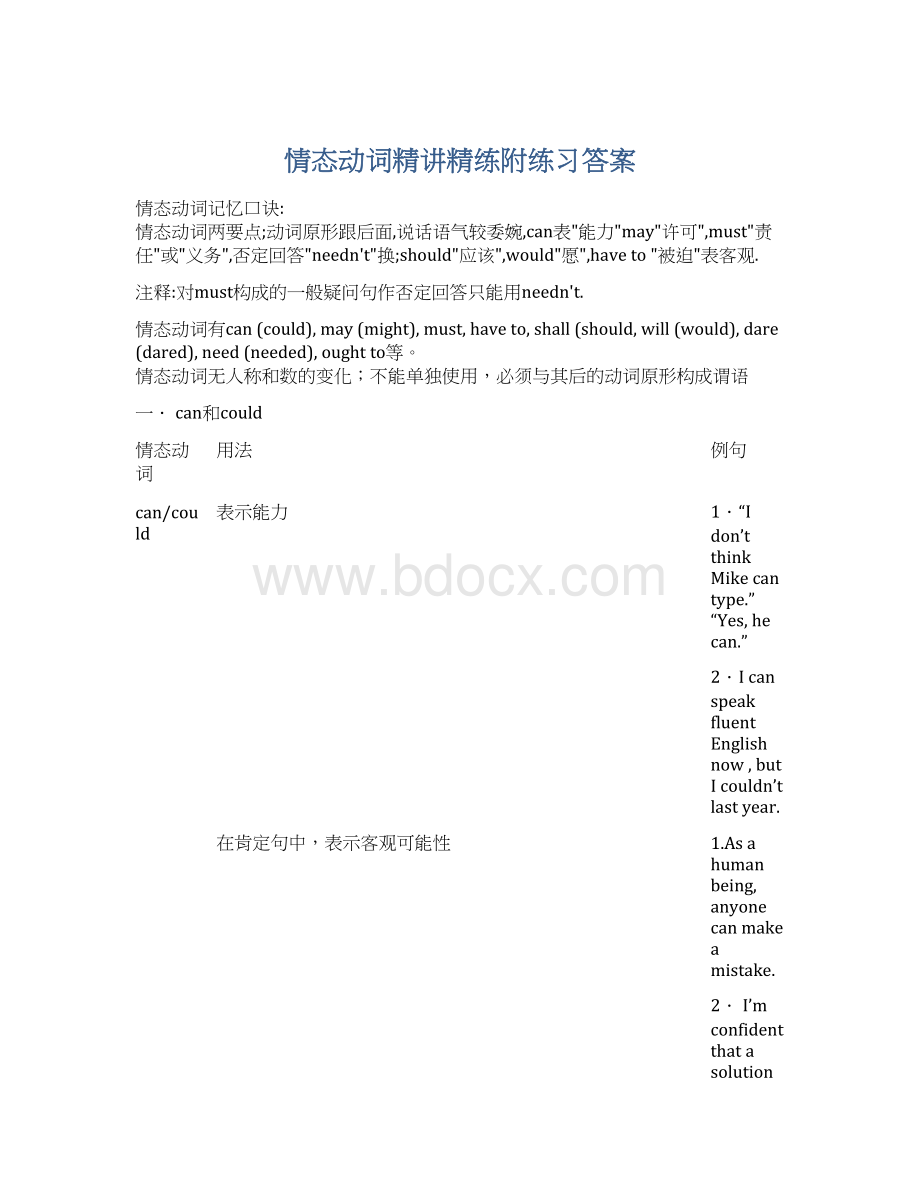情态动词精讲精练附练习答案文档格式.docx
《情态动词精讲精练附练习答案文档格式.docx》由会员分享,可在线阅读,更多相关《情态动词精讲精练附练习答案文档格式.docx(42页珍藏版)》请在冰豆网上搜索。

换;
should"
应该"
would"
愿"
haveto"
被迫"
表客观.
注释:
对must构成的一般疑问句作否定回答只能用needn'
t.
情态动词有can(could),may(might),must,haveto,shall(should,will(would),dare(dared),need(needed),oughtto等。
情态动词无人称和数的变化;
不能单独使用,必须与其后的动词原形构成谓语
一.can和could
情态动词
用法
例句
can/could
表示能力
1.“Idon’tthinkMikecantype.”“Yes,hecan.”
2.IcanspeakfluentEnglishnow,butIcouldn’tlastyear.
在肯定句中,表示客观可能性
1.Asahumanbeing,anyonecanmakeamistake.
2.I’mconfidentthatasolutioncanbefound.
3.Hecanbeveryforgetfulsometimes.
表示请求和允许。
表示请求,口语中常用could代替can,使语气更委婉。
1.Canweturntheairconditioneron?
2.Couldyouhavehercallmebackwhenshegetshome,please?
3.IwonderifIcouldjustaskyoutosignthis.
表示对现在的动作或状态进行主观的猜测,主要用在否定句和疑问句中。
1.Itcan’tbeeasycaringforamanandachildwhoarenotyourown.
2.Canthemanovertherebeourheadmaster?
特别说明:
(1)could用来表示请求时,语气委婉,主要用于疑问句,不能用于肯定句,答语应用can(即:
could不能用于现在时态的简略答语中)。
如:
——CouldIuseyourdictionary?
——Yes,youcan.(否定回答可用:
No,I’mafraidnot.)
(2)can和beableto辨析
can(could)和beableto都可以表示能力,意思上没有区别。
但can只有现在式和过去式,而beableto则有更多的形式。
I’vealwayswantedtoabletospeakfluentEnglish.
Thosebagslookreallyheavy,areyousureyou’llbeabletocarrythemonyourown?
但是,表示在过去某时的某一场合经过一番努力,终于做成了某事,通常不用could,而用was/wereableto来表示。
这时,was/wereableto相当于managedtodo或succeedindoing。
Aftertheaccidentitwasalongtimebeforeshewasabletowalkagain.
Thefirewasverybig,butmostpeoplewereabletoescapefromthebuilding.
(1)惯用形式“cannot…too…”或“cannot/never…..enough表示“无论怎么……也不(过分)”。
Youcan’tthinktoohighlyofhim.
Youcannotbetoocareful.=Youcanneverbecarefulenough.你越小心越好。
Ireallycannotthankyouenough.It’sbeenanamazingday.
(4)惯用形式“cannotbut+不定式(不带to)”表示“不得不,只好”。
Icannotbutadmireherdetermination.我不得不钦佩你的决心。
(5)惯用形式cannothelpbutdosthcannothelp(doing)sth作“忍不住,不禁”讲。
如:
Thegirlcouldn’thelpbutliveonherself.小女孩不得不自食其力。
WhenItrytospeak,Ican’thelpmakingmistakes.我一开口说话,就禁不住犯错误。
二.may和might
may/might
表示允许、许可。
否定回答一般用mustnot/mustn’t,表示“禁止、阻止”之意,但也可以用hadbetternot(最好别)或maynot(不可以),语气较为委婉。
1.MayIcomeinandwait?
2.——MayIsmokehere?
——No,youmustn’t
(或No,you’dbetternot.)
在表示请求、允许时,might比may语气更委婉些。
用MayI征询对方许可在文体上比较正式,在口气上比较客气,在日常用语中,用CanI征询对方意见更为常见。
1.MightIborrowyourpen?
2.IwonderifImightspeaktoyourson.
表示可能性的推测,通常用在肯定句和否定句中,含有“或许”“大概”“可能”之意;
用might代替may时,则语气显得更加不肯定。
1.Itmayrainthisafternoon.
2.Shemightcometojoinusthisafternoon.
3.Isupposehemighthavemissedthetrain.
may用于祈使句表示祝愿,倒装。
1.Mayyousucceed.
2.Longmayhelive!
愿他能持续住下去。
3.Maysherestinpeace.愿她安息。
惯用句式:
“maywell+动词原形”,表示“有充分的理由可以”或“有可能”。
相当于tobeverylikelyto
“mayaswell或might(just)aswell+动词原形”表示有礼貌地劝告,意为“还是。
。
的好”
1.Youmaywellsayso.你很有理由这样说。
2.Theremaywellbearealproblemhere.
3.Thereisnothingtodo,soImayaswellgotobed.
4.Youmayaswelltellusnow,we’llfindoutsoonerorlater..
三.must和haveto
must
表示“必须,应该”之意,语气比should,oughtto强烈。
其否定形式mustn’t表示“不准,不应该,禁止”等意
1.Youmustcometoschoolontime.
2.Everybodymustobeythelaw.
3Youmustn’tdrivesofastinthestreet.
4.Wemustn’twasteanymoretime.
在回答带有must的问句时,否定回答常用needn’t或don’thaveto.
1.—MustIcomebackbeforeten?
—Yes,youmust.(No,youneedn’t)
表示有把握的推测,意为“一定、准是、相必”,只用于肯定句中
1.Itmustbemymother.
2.Youmustbehungryafterawalk.
3.Theremustbeaholeinthewall.
表示说话人不满的语气。
“偏偏”“偏执”“固执”
1.Whymustyoualwaysinterruptme?
2.Itcan'
thelp.Hemustgowithme.
haveto
“必须,不得不”,意义与must相近。
但must表示的是说话人的主观看法,而haveto则往往强调客观需要。
1.Thefilmisnotinteresting.Ireallymustgonow.
2.Ihavetogonow,becausemymotherisinhospital.
must只有一种形式,即现在式与过去式都是一种形式,而haveto则涉及各种人称、时态等方面的变化形式。
1.IhadtoworkhardwhenIwasyourage.
2.Iwillhavetolearnhowtouseacomputer.
3.Inordertotaketheexam,we’llhavetofinishthewholebookbytheendofthismonth.
两者的否定意义不同,mustn’t表示“禁止,不许”,don’thaveto表示不必。
1.Youmustn’tgothere.
2.Youdon’thavetogothere.
1.must表示推测时,其反意疑问句应根据动词的实际时态而变化。
Itmustbenicetotakeawalkhere,isn’tit?
Tombuysalotofapples,hemustlikeeatingthem,doesn'
the?
2.Musthavedone的反意疑问句有三种情况:
①从句中含有过去的时间状语,反意疑问句用过去时.
Thegroundiswet,itmusthaverainedlastnight,didn’tit?
②从句中含有过去完成时的时间状语,反意疑问句用过去完成时.
Bytheendoflastterm,wemusthavelearnt2000words,hadn’twe?
③若从句中不含任何时间状语,反意疑问句用现在完成时
Wemusthavebeenmetsomewhere(before),haven’twe?
3.must表示“必须”“有必要”时,反义疑问句部分用mustn’t...?
或needn’t...?
Youmustgohomerightnow,needn’tyou?
4.must用否定形式mustn’t时,附加疑问句部分用may或must…?
Youmustn’tcheatintheexamination,mustyou?
四.shall和should
shall
用